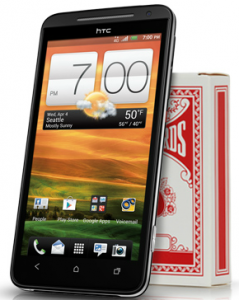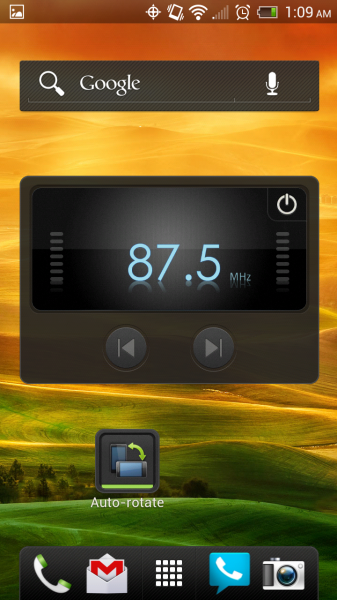HTC EVO 4G LTE review
 With the roll over to LTE from WIMAX, Sprint has taken the path to have Android 4.x on all its new 4G Android devices, the first being the Google flagship Galaxy Nexus. But one of the first third-party LTE Androids is the update to the HTC EVO line. The original HTC EVO 4G became the top-selling launch-day phone on Sprint back in 2010. Minor updates to the line followed, such as the EVO 3D, as well as a Star Wars-branded White R2D2 model. So how does the new HTC EVO 4G LTE, an Ice Cream Sandwich (Android 4.0.3) using HTC Sense 4.0 UI stack up to the family title in 2012?
With the roll over to LTE from WIMAX, Sprint has taken the path to have Android 4.x on all its new 4G Android devices, the first being the Google flagship Galaxy Nexus. But one of the first third-party LTE Androids is the update to the HTC EVO line. The original HTC EVO 4G became the top-selling launch-day phone on Sprint back in 2010. Minor updates to the line followed, such as the EVO 3D, as well as a Star Wars-branded White R2D2 model. So how does the new HTC EVO 4G LTE, an Ice Cream Sandwich (Android 4.0.3) using HTC Sense 4.0 UI stack up to the family title in 2012?
The EVO 4G LTE is only 0.35 inches thick, compared to the 0.5 inches of its predecessor, with a form factor of 5.3 inches by 2.7 inches. The screen is a sharp 4.7-inch Capacitive Super-LCD 2 -- 312 dots per inch with 720 x 1280 pixel resolution at 24-bit (16.7 million) color. To watch HD video is a joy; its easy and fair to say it is impressively crystal clear.
The EVO 4G LTE is powered by a 1.5 GHz Qualcomm Snapdragon S4, -- dual-core, not quad-core. Along with the 1GB of system RAM, the phone is almost mercurial in its snappy performance. The added set of on-process system-on-a-chip support includes 1900 Mhz LTE, CDMA2000; Bluetooth 4.0; WiFi supporting 802.11 a/b/g/n, WiFi Direct, WiFi hotspot access; micro-USB with MHL link; near field communication, and built-in FM radio. The major plus of the system-on-the-chip design: the phone doesn't seem to guzzle power off like its predecessors. Power only has to drive one major processor chip with the system-on-a-chip design of the Qualcomm Snapdragon S4, really saving on consumption. Which is good considering the EVO 4G LTE has a non-removable 2000 mAh Lithium Ion battery.
A Real Shooter
The HTC EVO 4G LTE comes with two cameras, the front facing one is a commendable 1.3 megapixel, perfect for video chat and Google+ Hangouts. The Camera on the back, though, is an impressive new backlight 8MP camera for handling low light extremely well, with LED flash and autofocus. The rear camera takes some impressive shots and has a bunch of built-in filter effects for the Instagram-using faithful. The phone even has a dedicated camera button, which I would love to see on all smartphones. The phone has built in 10GB of space, and support for Micro-SDHC up to 32GB.
At the time of my initial review the HTC EVO 4G had a major bug. Google Wallet wasn't working, despite Sprint being a major supporter. In what is being called a "software bug", nearly every non-google flagship NFC chip-carrying device on Sprint also was affected. Google, HTC and Sprint said they would release a software patch by the end of July. It seemed this bug only effected the Google Wallet app. Other NFC smart apps work as well as other features, such as NFC beaming, RFID chip scanning, and smart tag auto features all seem to work. The bug fix (version 1.22.651.3) released July 14, addressing the following issues:
- Google security updates
- WiFi connections
- Time zone
- Google Wallet
- Side-loaded video pause
- Random power cycling
- Pioneer Bluetooth Car Kit connection
- Gallery app crash
- Calendar reminder (all day even time)
With that software bug now fixed the only thing I found wanting -- from the multimedia playback features -- is the built-in speaker. It can only be heard if you cup the back of the phone, or place it down using the kickstand on a table. The speaker creates a mock virtual echo chamber, taking it from quiet to near booming when doing so. A rather impressive design function if on purpose, but it can be a trouble when listening to driving directions when there is no Bluetooth car audio support.
 Makes Sense?
Makes Sense?
Sense, the custom UI interface by HTC, has some creature comforts and sports the new update of grouped apps feature of Android 4.0 UI design, social media integration and profile backup. But like other custom UIs on other Android phones, Sense holds back the platform. Also unlike Galaxy Nexus, which makes the home, app, and back buttons part of the display UI, HTC is stuck on using permanent soft buttons, which takes real estate from the screen.
I love the hardware of the HTC EVO 4G LTE, I just wish people would use a standard system already for the UI. I get why companies like HTC do it, as how would customers delineate between the phones otherwise and the device experience, but I still don't like it. It's almost like the custom UIs hold back everyone, expanding Android fragmentation. Personally I would love to see the custom UI development teams put to work on custom hardware promoting apps like high-quality camera apps that would take advantage of the hardware perks of the HTC EVO 4G LTE's camera. But luckily HTC knows that a lot of fans of Android have the same feelings on custom UIs; they released the Kernel source code of the HTC EVO 4G LTE. This will allow third-party Android development teams, like Cyanogen Mod, to support the easy to root HTC EVO 4G LTE.
But in the end, the phone is beautifully designed. The sleek, slender form factor, even including the signature EVO 4G built-in kickstand, makes this a remarkable update. For the general consumer the phone is impressive, the responsiveness is great. I love the evolution and simple design of the HTC EVO 4G line. The slender form factor did have to give up the removable battery but in the sake of optimization performance increased from the Android 4.0 based firmware, and the SoC hardware integration, it's not a terrible loss.
If there's a shortcoming, it's LTE coverage. Earlier this week, Sprint officially launched the service in 15 new cities, which is a small spattering. The only trouble with the Sprint standard of LTE is that, at 1900 MHz, it will not easily penetrate buildings, unlike, say, Verizon's 700 MHz LTE. But unlike Verizon, Sprint LTE is uncapped and unlimited.
HTC EVO 4G LTE is $199.99 with two-year contract and has been available since June 2, 2012. A White HTC EVO 4G LTE has arrived at Sprint on July 15 for the same price.
